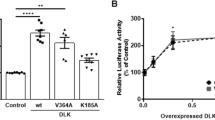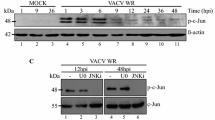Abstract
Insulin and vanadate function as complete mitogens for SV40-transformed murine 3T3T (CSV3-1) cells but not for nontransformed 3T3T cells. Mitogenesis induced by insulin and vanadate in CSV3-1 cells is associated with the induction of the expression of protooncogenes c-Jun and junB, two major AP-1 transcription factor components. We now report that both insulin and vanadate induce a significant increase in AP-1 DNA binding activity in CSV3-1 cells but not in 3T3T cells. Gel supershift assays and Western blot analysis using specific antibodies demonstrate that the increased AP-1 binding activity induced by insulin and vanadate in CSV3-1 cells is primarily contributed by an increase in the expression of c-Jun and JunB protein levels. Furthermore, treatment of CSV3-1 cells with antisense oligodeoxyribonucleotides to c-Jun or to junB blocks insulin- and vanadate-induced mitogenesis whereas antisense junD oligomers have no inhibitory effects. These results therefore demonstrate that the induction of AP-1 binding activity associated with c-Jun and JunB is required for insulin- and vanadate-induced rnitogenesis in SV40-transformed murine 3T3T cells. Additional data presented in this paper show that JunD/AP-1 binding activity, which is thought to play a negative role in regulating cell proliferation, is also slightly induced following insulin and vanadate stimulation in CSV3-1 cells. Nevertheless, the ratio of proliferation promoting c-Jun/AP-1 and JunB/AP-1 binding activities to proliferation inhibiting JunD/AP-1 binding activity is significantly increased following insulin and vanadate stimulation. These results therefore support the concept that modulation of the balance of positive Jun/AP-1 and negative Jun/AP-1 activities is important in regulating cell proliferation.
Similar content being viewed by others
References
Angel P, Karin M: The role of Jun, Fos and the AP-1 complex in cell-proliferation and transformation. Biochim Biophys Acta 1072: 129–157, 1991
Ryseck R-P, Hirai SI, Bravo R: Transcriptional activation of c-jun during the G0/G1 transition in mouse fibroblasts. Nature 334: 535–537, 1988
Ryder K, Lau LF, Nathans D: A gene activated by growth factors is related to the oncogene v-jun. Proc Natl Acad Sci USA 85: 1487–1491, 1988
Ryder K, Nathans D: Induction of protooncogene c-jun by serum growth factors. Proc Natl Acad Sci USA 85: 8464–8467, 1988
Boyle WJ, Smeal T, Defize LHK, Angel P, Woodgett JR, Karin M, Hunter T: Activation of protein kinase C decreases phosphorylation of c-Jun at sites that negatively regulate its DNA-binding activity. Cell 64: 573–584, 1991
Miner JN, Diamond MI, Yarnamoto KR: Joints in the regulatory lattice: composite regulation by steroid receptor-AP1 complexes. Cell Growth Differ 2: 525–530, 1991
Wang H, Scott RE: Adipocyte differentiation selectively represses the serum inducibility of c-jun and junB by reversible transcription-depend-ent mechanisms. Proc Natl Acad Sci USA 91: 4649–4653, 1994
Herschman HR: Primary response genes induced by growth factors and tumor promoters. Annu Rev Biochem 60: 281–319, 1991.
Smith MJ, Prochownik EV: Inhibition of c-jun causes reversible proliferative arrest and withdrawal from the cell cycle. Blood 79: 2107–2115, 1992
Brach MA, Gruss H-J, Sott C, Herrmann F: The mitogenic response to tumor necrosis factor alpha requires c-Jun/AP-1. Mol Cell Biol 13: 4284–4290, 1993
Ryder K, Lanahan A, Perez-Albuerne E, Nathans D: Jun-D: A third member of the Jun gene family. Proc Natl Acad Sci USA 86: 1500–1503, 1989
Hirai S-I, Ryseck R-P, Mechta F, Bravo R, Yaniv M: Characterization of junD: a new member of the jun proto-oncogene family. EMBO J 8: 1433–1439, 1989
Pfarr CM, Mechta F, Spyrou G, Lallemand D, Carillo S, Yaniv M: Mouse JunD negatively regulates fibroblast growth and antagonizes transformation by ras. Cell 76: 747–760, 1994
Lasky SR, Iwata K, Rosmarin AG, Caprio DG, Maize AL: Differen-tial regulation of JunD by dihydroxycholecalciferol in human chronic myelogenous leukemia cells. J Biol Chem 270: 19676–19679, 1995
Bossy-Wetzel E, Bravo R, Hanahan D: Transcription factors junB and c-jun are selectively up-regulated and functionally implicated in fib-rosarcoma development. Genes Dev 6: 2340–2351, 1992
Wang H, Xie Z, Scott RE: Differentiation modulates the balance of positive and negative Jun/AP-1 activities to regulate cellular proliferative potential: different effects in nontransformed and transformed cells. J Cell Biol (in press)
Wang H, Scott RE: Insulin-induced mitogenesis associated with transformation by the SV40 large T antigen. J Cell Physiol 147: 102–110, 1991
Wang H, Wang J-Y, Johnson LR, Scott RE: Selective induction of c-jun and junB but not c-fos or c-myc during mitogenesis in SV40-trans-formed cells at the predifferentiation growth arrest state. Cell Growth Differ 2: 645–652, 1991
Wang H, Scott RE: Unique and selective mitogenic effects of vanadate on SV40-transformed cells. Mol Cell Biochem 153: 59–67, 1995
Wang H, Scott RE: Induction of c-jun independent of PKC, pertussis toxin-sensitive G protein, and polyamines in quiescent SV40-transformed 3T3T cells. Exp Cell Res 203: 47–55, 1992
Wang H, Scott RE: Distinct protein tyrosine phosphorylation during mitogenesis induced in quiescent SV40-transformed 3T3T cells by insulin or vanadate. J Cell Physiol 158: 408–416, 1994
Diamond L, O'Brien TG, Rovera G: Inhibition of adipose conversion of 3T3 fibroblasts by tumour promoters. Nature 269: 247–249, 1977
Scott RE, Hoerl BJ, Wille JJ, Jr, Florine DL, Krawisz BR, Yun K: Coupling of proadipocyte growth arrest and differentiation. II. A cell cycle model for the physiological control of cell proliferation. J Cell Biol 94: 400–405, 1982
Estervig DN, Minoo P, Tzen C-Y, Scott RE: Inhibition of simian virus 40 T-antigen expression by cellular differentiation. J Virol 63: 2718–2725, 1989
Estervig DN, Minoo P, Tzen C-Y, Scott RE: Three distinct effects of SV40 T-antigen gene transfection on cellular differentiation. J Cell Physiol 142: 552–558, 1990
Wang H, Stunevant DB, Scott RE: Nonterminal and terminal adipocyte differentiation of murine 3T3 T mesenchymal stem cells. In: J.E. Celis (ed.). Cell Biology: A Laboratory Handbook. Academic Press, San Diego, 1994, pp 193–198
Ye Z-S, Samuels HH: Cell-and sequence-specific binding of nuclear proteins to 5′-flanking DNA of the rat growth hormone gene. J Biol Chem 262: 6313–6317, 1987
Otter T, King SM, Witman GB: A two-step procedure for efficient electrotransfer of both high-molecular-weight (> 400,000) and low-molecular-weight (< 20,000) proteins. Anal Biochem 162: 370–377, 1987
Brennscheidt U, Riedel D, Kolch W, Bonifer R, Brach MA, Ahlers A, Menelsmann RH, Herrmann F: Raf-1 is a necessary component of the mitogenic response of the megakaryoblastic leukemia cell line MO7 to human stem cell factor, granulocyte-macrophage colony-stimulating factor, interleulcin 3, and interleukin 9. Cell Growth Differ 5: 367–372, 1994
Angel P, Hattori K, Smeal T, Karin M: The jun proto-oncogene is positively autoregulated by its product, Jun/AP-1. Cell 55: 875–885, 1988
Berger I, Shaul Y: The human junD gene is positively and selectively autoregulated. DNA Cell Biol 13: 249–255, 1994
Author information
Authors and Affiliations
Rights and permissions
About this article
Cite this article
Wang, H., Xie, Z. & Scott, R.E. Induction of AP-1 activity associated with c-Jun and JunB is required for mitogenesis induced by insulin and vanadate in SV40-transformed 3T3T cells. Mol Cell Biochem 168, 21–30 (1997). https://doi.org/10.1023/A:1006889623326
Issue Date:
DOI: https://doi.org/10.1023/A:1006889623326




